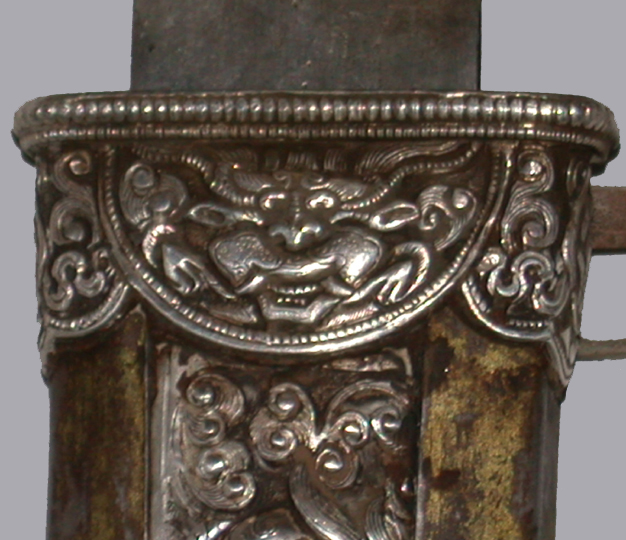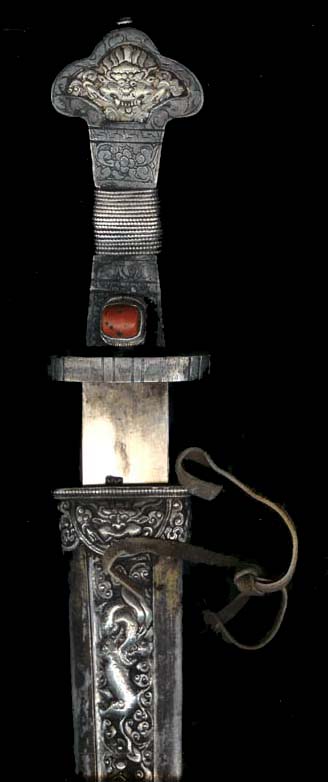Short Sword (Lokang in Kham dialect)Kham Province, Eastern Tibet - Silver,coral, turquois & iron - 2 ⅝ (6.6 cm.) wide - 16 ¾ (42.55 cm.) long - 19th century
Iron, silver, coral & turquoise short sword (Lokang in the Kham dialect). Lokang means “side leg” (lo – “side”; kang – “leg”). It is a leg sword that was worn hanging from a Kham nomad’s belt down his right side. A distinctive trait of Khampa swords is that when they are pulled out of their sheaths with the top of the sheath (left picture) facing up, the sharp blade of the sword was on the left. In other countries, it is on the right. In a fight, a Khampa man hit another man with the flat or blunt side, because the aim was not to kill, but merely to win the fight. When a Khampa turned the blade side towards his opponent, he intended to inflict serious harm.1 The front of this hilt has a silver Tzipah (“Face of Glory”) over an incised lotus flower & a silver wire wrapping that forms the grip. On top of the scabbard is a horizontal border with a second silver Tzipah flanked by a Cintamini (“Wish-Fulfilling Jewel”) on each side & lotus leaves on the back. Under the Tzipah on the front are a vertical silver repoussé panel with a Chinese foo lion, two inset corals & one turquoise that represent a Triratna (“Three Jewels”) & another Qing dragon holding a pearl in its claws. The dome on the bottom of the scabbard has swirling leaves around a lotus flower center. The back of the hilt has a Qing-style dragon on top over another incised lotus flower. On the back of the scabbard is a vertical incised silver panel with a tiger, a bird & a snow lion surrounded by leaf patterns. The knife blade is stamped with Chinese silver marks, which say that the blade was made by the Achang tribe in Yunnan Province, Southern China near the Burmese border. The Achang practiced Hinayana Buddhism & were known for their unique & superior knife making techniques, which had a six hundred year old history that started during the Ming Dynasty. The Achang blade was probably attached to the handle in Derge. Qing elements were prominent on objects from Eastern Tibet, which is on the Chinese border, because it was directly administered by Manchu China during the period when this knife was fabricated. Derge was famous throughout Tibet for its metal work. The Khampas were nomadic warriors known for their bravery, their handsome faces & tall bodies, their skill with horses & their intrepid independence. They helped the 14th Dalai Lama escape from Lhasa during the 1959 uprising. Derge, Kham Province, Eastern Tibet. 2 ⅝” (6.6 cm.) wide X 16 ¾” (42.55 cm.) long. Circa early-mid 19th century. 1The Khampa name lokang, its translation & information about Khampa swords is from Samten Dakpa (b. 1980), a Khampa nomad artist who grew up in a tent in Yushu.
Chinese silver mark
The Chinese silver mark on the blade indicates that it was made by the Achang tribe in Yunnan Province, Southern China. The Achang practiced Hinayana Buddhism while Tibetans practiced Mahayana Buddhism. The Achang were famous for their knives & swords. Their fabrication technique had a six hundred year old history, which probably started during the Ming Dynasty.
|








